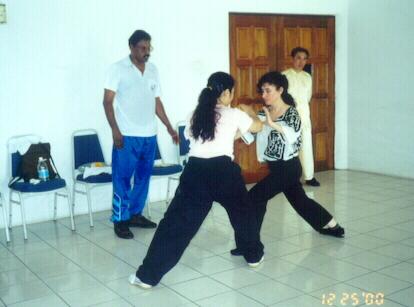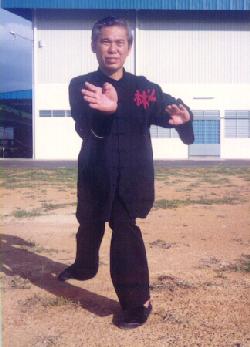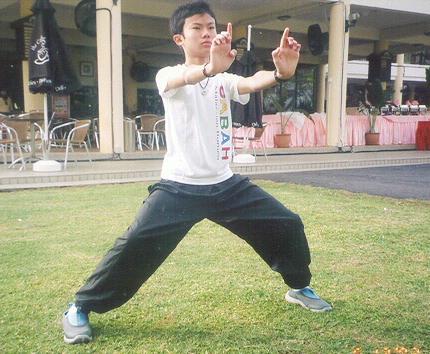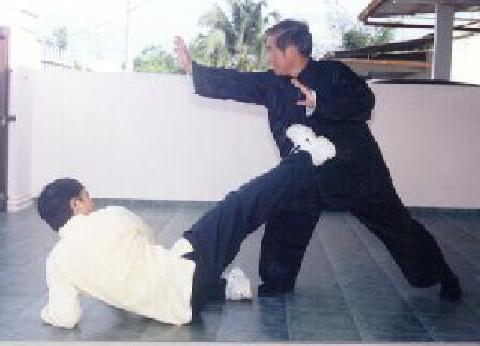June 2001 (Part 1)
SELECTION OF QUESTIONS AND ANSWERS

Sparring is an essential aspect of genuine kungfu training. In an Intensive Shaolin Kungfu Course in Malaysia, Emiko (left) from Japan practised sparring with Adalia from Spain, while Mogan and Sifu Wong looked on. It is worthy of note that in kungfu sparring, size and sex do not matter. Both these elegant ladies also sparred with Mogan, who is strong and big-sized even for men.
Question 1
How long after sex (with ejaculation) should a man wait before it is safe to practise chi kung? For example could one practise “Lifting the Sky” a few hours later? A well known master suggests at least 24 hours should pass before practice and maybe even 3-4 days.
— Hedges, UK
Answer
It depends on the type of chi kung as well as some relevant factors. In the past, when one talked about chi kung, what was usually referred to was martial art chi kung like Iron Shirt and Golden Bell, where training was strenuous. Practitioners of martial art chi kung often abstained from sex, especially during the foundation period of their training. If they had sex, thy would rest for about three days before resuming their strenuous routine. Many classical chi kung texts also gave this advice.
On the other hand, physicians prescribed medical chi kung to their patients. The patients were strongly advised to abstain from sex so that whatever energy they had could be focused on the recovery process. Medical texts also mentioned this point. Probably because many chi kung teachers today do not fully understand the background of the abstinence advice given in chi kung texts, told their students to abstain from sex or rest for some time after sex.
Today conditions have changed. At present most people practise chi kung not for martial or medical purposes, but for good health, vitality and longevity, and the type of chi kung they practise is generally gentle.
It is actually recommendable for a man to do some gentle chi kung exercise almost immediately after sex. “Lifting the Sky” would be an excellent exercise. This will not only replenish the energy lost during his sexual effort, but also facilitate the mixing of his male energy with the female energy he just absorbed, making him fresh and energetic again.
For a woman, however, she should rest in bed for a while, about 15 minutes to half an hour, and let the male energy she just absorbed soak into her. The mixing of her female energy with the male energy will rejuvenate her, making her complexion lovely and her temperament pleasant. After rising, she could perform some gentle chi kung exercise, like “Lifting the Sky”.
This of course presumes that both the man and the woman are healthy, and that they are not worried about possible conception. But if for any reasons they have taken safety or contraceptive measures, the man should also perform some gentle chi kung exercise, and the woman rest. Why should the man exercise and the woman rest? It is because of their different nature
On the other hand, it is not advisable for a man to have sex immediately after chi kung, because as he has generated a vigorous chi flow, the ejaculation would drain away his energy. He should wait for about half an hour. If he or his partner is impatient, 15 minutes would be a compromise.
Question 2
I would like to become vegetarian as I do not agree with the way animals are farmed in the UK. I once sustained a vegetarian diet for about a year but I became increasingly weak and then I began to lose concentration and my mind became agitated. Could this be explained from a traditional Chinese medical perspective.
— Paul, UK
Answer
Yes, the Chinese medical perspective can explain this well, and many people, including Western medical scientists, would benefit from looking at the same problems from a new perspective. Let us look at your problems one at a time and see the difference a new perspective would make. Then we may also examine other problems facing Western societies, and benefit from the new outlook.
When you disagree with the way animals are farmed, you become vegetarian. This is the strategy many people would take, and for convenience let us call this change a locational or an external shift. Another strategy is to remain where you are, but you improve yourself so that you can adjust to the change. We call this a functional shift or an internal shift.
There are many other problems in the West whereby the usual strategy adopted by most people involves a locational or external shift. For example, if sugar is seen as the cause of diabetes, many people take little or no sugar. If burning of fat in vigorous exercise is seen as reducing weight, they go for gym work and aerobics.
Another strategy is to stay where you are, i.e. continue your normal lifestyle, but improve you body functions internally to digest whatever sugar and fat you have to take.
These strategies can be concisely explained by the Chinese concept of yin-yang harmony. Yin-yang harmony results in well-being, whereas yin-yang disharmony results in illness. Yin represents your adjustment to changing conditions, and yang represents factors that can cause illness.
Illness resulting from taking badly farmed meat, sugar or fat is symbolized by excessive yang, which causes disharmony. Your strategy is to shift location, to bring your yin-yang harmony to a different set of conditions where yang now represents vegetable and non-sugar and non-fat food.
The alternative strategy is to work on yin instead of changing yang. You increase yin so that it can harmonize with the increased yang, i.e. you improve your own body functioning so that even if the animals are from industrialized farming or the food contains sugar and fat, you not only can take them without harm but change the raw material into useful energy and effectively dispose off the toxic waste.
Daily experience has shown that the first strategy of changing yang has not been effective. It is also worthy of note that most other people can take meat, sugar and fat, and have no problems. This is because their yin is able to harmonize with yang. We are of course talking about normal conditions. If a specific condition occurs, like an epidemic of mouth-foot disease caused by infected meat, we have to abstain from meat for the time being.
The second problem is that you became increasingly weak, lost concentration and your mind became agitated. This is a result of your strategy failing you. In Chinese medical concept, this problem is caused by insufficient yang, which also causes illness. Your body systems are unable to adjust to the change from meat-eating to vegetable-eating.
You can overcome these two problems by practising chi kung, but it must be genuine chi kung and you have to practise correctly. The forte of chi kung is to promote harmonious energy flow with the result of yin-yang harmony.
In simple language it means chi kung improves your body (and mind) functioning so that you can better adjust to constantly changing conditions. If you take meat, sugar or fat, your body will convert them to useful energy and disposes off toxic waste. If you take vegetable instead, your body will also convert it to useful energy and disposes off toxic waste.

A Shaolin pattern called “Dark Dragon Draws Water” demonstrated by Sifu Wong. Practising kungfu form is only one aspect of kungfu training, and in many ways it is the least important aspect. But many kungfu schools today merely practise form, and nothing else. This is one main reason why most kungfu students today cannot spar efficiently.
Question 3
I thought that if I practised chi kung it would help me overcome these problems and I could again take up the diet. However after one month of diet change I again feel these symptoms coming back even with continued chi kung practise and a high intake of vegetable protein and some fish. I find it very difficult to train when my mind is weak.
Answer
Probably you only practised gentle physical exercise, although you and even your teacher thought it were chi kung. Not only you have to practise genuine chi kung, which is quite rare today, you also have to practise it correctly, which is not easy if you are not supervised by a competent instructor.
After subjecting your body to vegetable for one year, you suddenly change to meat. Your body is unable to adjust to the change. This again can be explained by the principle of yin-yang harmony. Your yin is unable to adjust to changing yang.
Taking high dose of food supplements, whether vegetable or inorganic, which is symbolized as strengthening yang, often makes existing problems more complicated. Other examples, often found in Western societies, including injecting artificial chemicals into the body to enhance its functions, and draining natural fat from the body to make it look slim.
Many people, including doctors, are perplexed at the complications which medical or surgical treatment sometimes bring. It is complicating because they look at problems from a localized and reductionistic perspective, when the problems actually affect the whole person in countless inter- connecting ways.
For example, viewing your problems from the Western medical perspective operating solely at a physical level, it is difficult to understand why your mind becomes weak. Doctors may conjecture that it is due to lack of certain chemicals in the brain, and consequently may prescribe these chemicals as supplements.
From the Chinese medical perspective, such chemotherapy at best only relieves the symptoms, but worse, when the medication is prolonged it may lead to long term complications. Interestingly, while the Chinese view man in his countless inter-connections within himself as well as with the whole universe, all these countless inter-connections and their myriad workings are generalized into amazingly simple principles, like yin-yang harmony and interaction among "jing", "qi" and "shen".
In Chinese medical philosophy, a person is composed of three components, namely "jing", "qi" and "shen", which means physical body, energy and mind. These three components are inter-related. You became increasingly week because your body fails to convert meat or vegetable into useful energy, and whatever energy left in your body is prevented to flow smoothly to wherever it is needed due to the disposition of toxic waste that your body also has failed to clear.
Because your energy flow is distorted, your mind also becomes weak. Your conditions are expressed in Chinese medical jargons as "when jing is weak, qi becomes weak; when qi is weak, shen becomes weak."
From the Chinese perspective, adding supplements to strengthen your body or your mind may work for a limited ad hoc purpose, but cannot overcome the root cause of your problems. What is the root cause? It is yin-yang disharmony.
Some intermediate factors, which we need not even have to identify, have caused your energy network to be distorted, which means your body lacks the vital energy to digest whatever food you have eaten for strengthening your body and mind. Once your energy network is restored to normal, you will regain your health, physically, emotionally and mentally. And this is best attained through genuine chi kung, the art of energy management.
Question 4
I would like to know whether or not you could do empty force to knock down a person?
Answer
No, I could not use “empty force” to knock down a person.
Sometimes some students would tell me they could feel a force rushing at them when I demonstrated a strike in front of them. But this force was only discernable; it was not strong enough to knock them down.
Many years ago one of my students, who is a master on his own, told me two aggressive masters of another martial system wanted to test him in his school. As one of them rushed at him, my student gently pushed his palm forward. The attacker tripped and fell.
The other person rushed in. My student did the same thing, and the other attacker also fell. All were surprised — my student the most.
It was probably a co-incidence, or due to some other reasons, as my student could not repeat this feat. Moreover, he had never trained “empty force”.
Question 5
Is it true Master Wang Zhia Chai and Yang Lu Chan also had this ability, so that was why they were undefeatable?
Answer
I am not sure if Master Wang Zhia Chai and Master Yang Lu Chan had this ability. There is no doubt they were great masters and had tremendous internal force, but as far as I know there has been no records that any one of them knocked down opponents by using “empty force”.
These two masters also did not train “empty force”, known in Chinese as “Pi Kong Zhang”, as a specialty. But I believe that if any one of them were to strike his palm across, say, ten feet at an ordinary person without any training in martial art, the latter would be injured.
It was true both Master Wang Zhia Chai and Master Yang Lu Chan did not lose a single combat. They were undefeatable not because of “empty force” but because of their exceedingly high skills and tremendous Xingyi internal force and Taiji internal force.
Pi Kong Zhang is recorded in kungfu literature as one of the three ultimate martial arts, the other two being Yi Zhi Chan (One-Finger Zen) and Shao Lin Shen Quan (Shaolin Marvellous Fist). A master of any one of these ultimate arts could knock down an opponent from a distance. Unfortunately there are no records as who actually had demonstrated this ability.

Besides sparring practice, another essential aspect in genuine kungfu training is to develop force. One excellent way is zhang zhuang, or stance training. Here Wong Chun Yian performs the Golden Bridge.
Question 6
I enjoy a lot the poetic and pleasant sounding four characters names of the gungfu techniques.
I would like to ask if you could help me and other readers with the Chinese names of the following techniques.
— Pavel, Czech Republic
Answer
The Chinese names of the following techniques or patterns are given below. I have used the Cantonese pronunciation because the patterns are from southern Shaolin Kungfu, which is frequently spoken in Cantonese among most of its practitioners.
This is due to its historical background. Southern Shaolin Kungfu was mainly developed in the Kwangtung (Guangdong) Province of south China, where the main language is Cantonese, and most of the masters who spread southern Shaolin Kungfu all over the world came mainly from Kwangtung.
- Angry Bull Charges at Fence — Lou Ngow Chong Lan.
- Bail up Water to Rice Field — Put Shoui Sheong Thien.
- Big Boss Offers Wine — Pa Wong King Chow.
- Breeze Blows Floating Vegetation — Foong Choui Fau Pheng
- Carp Turns its Tail — Li Yue Fan Shun.
- Dark Dragon Draws Water — Wu Loong Choui Shoui.
- Felling Tree with Roots — Thou Shyi Phoon Khern.
- Fierce Tiger Crouching on Ground — Mang Fu Fok Theai.
- Fierce Tiger Speeds Through Valley — Mang Fu Kor Len.
- Fisherman Casts Net — Yui Yoong Sat Mong.
- Golden Bird Grips Eyebrow — Kam See Phan Mei.
- Golden Leopard Watches Fire — Kam Pau Khoon For
- Happy Bird Hops up Branch — Hei Cheok Tang Chi.
- Horizontally Sweep Thousand Armies — Wang Sou Chin Khun.
- Intercept Big Boss — Lan Khong Chik Pa.
- Naughty Monkey Kicks Tree — Wan Hou Theat Shyu.
- Poisonous Snake Basking in Mist — Tok Seai Ta Mou.
- Reversed Hanging of Golden Lotus — Tou Kwa Kam Lin.
- Reversed Striking of Purple Bell — Tou Ta (Qi) Kam Choong.
- White Crane Steps on Snow — Pa Hok Tap Shuet.
- White Snake Shoots Venom — Pak Seai Tou Shoon.
- Yellow Bird Drinks Water — Wong Ngang Yam Shoui.
Question 7
I have been studying kungfu for about 1 1/2 years. My master informed me that I would not be able to spar for about 7 years until I had learnt most of the style.
— Adam, UK
Answer
Kungfu is a martial art. If one has to spend seven years learning the form before he learns sparring, the art or the method of teaching it is grossly ineffective. The phrase “until I had learnt most of the style” suggests that the repertoire of this style, or of the teacher, consists chiefly of kungfu sets.
Little of the repertoire is devoted to sparring, and perhaps nothing is devoted to force training. This in fact is the norm in most kungfu schools today, where haphazard free sparring and crude weight training are innovations by enterprising students borrowing methods from karate and weight-lifting.
If you examine classical kungfu literature recording how kungfu was practised in the past, you would find that set practice, i.e. learning kungfu form, constituted only a small part of the training programme. For an exponent who had spent 10 years in kungfu training, the first year would be spent on learning kungfu form, and the remaining nine years on force training and sparring.

Sifu Goh Kok Hin uses the pattern “Reverse Striking of Purple Bell” to attack Sifu Wong
Question 8
Do you think this would help in the area of sparring? Would this enable me to learn so much about the style and its applications that I should have better knowledge of using them whilst free sparring, and not reverting to any form of Karate, Taekwondo or Kickboxing?
Answer
No, this would not help you in sparring. I think that after seven years, or even after 25 years, even when you have learnt so much about the style and its application (in theory), you would spar like children. If you spar with a blue-belt in karate or taekwondo, or with a novice in kickboxing, you would be punched and kicked all over by him. This is actually the case with most so-called kungfu or wushu students today, although these students could perform routine kungfu sets beautifully.
Why? The reason is simple. The blue-belts or kickboxing novices have practised sparring for a few months, the kungfu or wushu students have no sparring practice at all.
If these kungfu or wushu students suggest to their teacher to have sparring practice, the teacher might say that Chinese kungfu is very deadly and thus sparring is dangerous. If they enquire how they could learn self-defence without sparring practice, he might say that after practising for “ten years or eight years” they could fight.
All this, of course, is not true. Practised correctly, kungfu sparring is safe. There are far more injuries resulting from sparring in karate, taekwondo and kickboxing than in kungfu, even with weapons. In sparring in most other martial arts, students exchange punches and kicks freely; in kungfu they are not supposed to be hit even once.
Question 9
Also, would studying Shaolin Kung-Fu be easier or more enjoyable if it is learnt in the country it originated from? I have always had a dream of learning in the Shaolin Temple amongst the monks. Would my not being Chinese shatter my dream?
Answer
Practising genuine Shaolin Kungfu — in China, the United Kingdom, Sudan or anywhere in the world — is never easy. First, finding a genuine Shaolin master who is willing to teach you, is very difficult. The actual practice itself is very hard work. But the rewards are tremendous. A saying in Chinese (Cantonese) reads as follows:
- hok tak sil lam chen miu fatt
- hou pei tim seak pin kam juin
It means
- Being successfully trained in genuine Shaolin arts
- Is better than having the magic touch to change stones to gold
Most people would think the expression an exaggeration. Personally I can vouch for the truth of this expression. If you appreciate that genuine Shaolin training actualize your full potential — in all your physical, emotional, mental and spiritual dimensions — you may appreciate that it is better than becoming fabulously wealthy.
I think it is more difficult and less enjoyable to learn genuine Shaolin Kungfu in China. It is very difficult to find genuine Shaolin masters even in China, and even if you can find one he is not likely to teach you, especially when you are unfamiliar with traditional master-student relationship, and think that learning from a master is doing him a favour, or that it is his duty to teach any Tom, Dick and Harry if they desire to learn.
If you had the unbelievable luck to learn from a genuine Shaolin master in China, you would find your learning less enjoyable than, say, in the United Kingdom. For example, you would not drive to his apartment, say “Hi, good morning,” then have tea served by him, before starting your morning training.
Instead you would have to track half a mile to his humble shed, prostrate before him in a customary way, rush to a nearby stream to bring back two pots of water which you would carry using your tiger-claws, boil the water and serve him tea, then practise your Horse-Riding Stance with the two pots on your thighs, while he slowly sips tea and admires the sky, perhaps with a cane in his hand, ready to whack you if the pots fall.
But you won't get such treatment at the Shaolin Temple today. Traditional Shaolin Kungfu is not taught in the Temple nowadays. But you can register yourself with any of the numerous schools around the Temple. These schools also do not teach traditional Shaolin Kungfu, but they teach wushu, a modernized form of kungfu promoted as sport. The instructors often wear monks' robes.
As the Shaolin Temple today does not teach Shaolin Kungfu, whether your being non-Chinese is a hindrance, becomes an irrelevant question. But in the past, although the Shaolin Temple was, and still is, Buddhist, one's race and religion did not make any difference.
